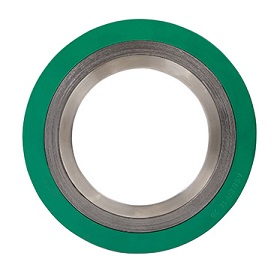Understanding Spiral Wound Gaskets: Essential Components for Sealing Systems
2025-01-23
In industrial applications, maintaining a secure and leak-proof seal is crucial to ensure the safety, efficiency, and longevity of machinery and equipment. Among the various sealing solutions available, spiral wound gaskets stand out as one of the most reliable and versatile options. In this blog, we’ll explore the characteristics, benefits, and applications of spiral wound gaskets, shedding light on why they are a go-to choice for industries requiring effective sealing.
What is a Spiral Wound Gasket?
A spiral wound gasket is a type of mechanical gasket composed of alternating layers of metal and soft filler material wound together in a spiral configuration. The metal provides strength and resilience, while the filler material (typically made from graphite, PTFE, or other elastomers) ensures a tight seal and compensates for any surface irregularities.
The construction of a spiral wound gasket consists of:
- Metal Strip: Typically made from stainless steel or other high-strength metals, the metal strip adds strength, resistance to pressure, and helps prevent deformation during operation.
- Filler Material: This layer fills any gaps in the flange surface, compensates for imperfections, and enhances the gasket's sealing ability under various pressures and temperatures.
Key Features and Advantages of Spiral Wound Gaskets
1. High Pressure and Temperature Resistance
Spiral wound gaskets are designed to perform under extreme conditions. The combination of metal and filler materials allows them to handle high pressures and temperatures, making them ideal for use in industries like petrochemical, oil and gas, and power generation.
2. Versatility
These gaskets can be used with a variety of flange types, including flat face, raised face, and ring-type joints. They can also be tailored to suit different sealing requirements by adjusting the type of filler material, metal strip material, and winding technique.
3. Excellent Sealing Capabilities
The spiral wound design ensures that the gasket forms a tight seal by distributing pressure evenly across the entire surface. This makes it effective in sealing against gases, liquids, and other challenging substances.
4. Resistance to Corrosion and Chemical Attack
Thanks to the use of corrosion-resistant metals like stainless steel, spiral wound gaskets are highly resistant to chemical attacks and corrosion, ensuring a long-lasting, reliable seal even in harsh environments.
5. Self-Adjusting
Spiral wound gaskets are self-adjusting, meaning they can adapt to changes in pressure or temperature. This characteristic helps maintain the integrity of the seal over time, even in fluctuating operating conditions.
Applications of Spiral Wound Gaskets
Spiral wound gaskets are commonly used in a variety of industries due to their robust sealing capabilities. Some of the primary applications include:
- Petrochemical and Oil & Gas Industries: In these industries, equipment such as flanges, valves, and pumps are exposed to high temperatures and pressures. Spiral wound gaskets help ensure safe, leak-free operations in refineries, pipelines, and other critical systems.
- Power Generation: In power plants, spiral wound gaskets are used in boilers, heat exchangers, and steam systems to prevent leaks and improve energy efficiency.
- Chemical Processing: Spiral wound gaskets are ideal for sealing in chemical reactors, tanks, and pipelines, where they provide resistance to both high temperatures and a wide range of chemicals.
- Marine and HVAC Systems: In marine engines and HVAC systems, these gaskets offer superior sealing properties in both corrosive and high-pressure environments.
Types of Spiral Wound Gaskets
Spiral wound gaskets come in various designs to meet specific requirements:
1. Standard Spiral Wound Gaskets: These gaskets have a basic design with alternating metal and filler materials and are used for general sealing applications.
2. Kammprofile Gaskets: These gaskets combine the spiral wound gasket with a flat, metal core. They are particularly useful for applications where higher pressure sealing is required.
3. R/T (Ring Type) Spiral Gaskets: These gaskets feature a metal ring and a spiral wound construction, offering superior sealing and strength for high-temperature, high-pressure environments.
How to Choose the Right Spiral Wound Gasket
Selecting the correct spiral wound gasket for your application involves considering several factors, such as:
- Operating Pressure and Temperature: Ensure the gasket material and design can handle the pressures and temperatures of your system.
- Chemical Compatibility: Choose a filler material that is compatible with the substances in your system to prevent chemical degradation.
- Flange Type: Match the gasket to the flange design (flat face, raised face, etc.) to ensure a proper seal.
- Size and Dimensions: Accurate sizing is essential for effective sealing. Always measure the flange dimensions carefully before selecting a gasket.
Conclusion
Spiral wound gaskets are an integral part of modern industrial sealing systems. Their durability, high resistance to pressure and temperature, and ability to adapt to various flange types make them indispensable in industries where leakage could pose serious risks. Whether you're working in petrochemicals, power generation, or chemical processing, spiral wound gaskets offer a reliable, long-lasting solution for maintaining the integrity of your systems.
By understanding their features, advantages, and applications, you can make more informed decisions when selecting a gasket for your specific needs. Always ensure that you choose the right material and configuration for optimal performance in your system.



